Our Verdict
A dab hand at 1080p and 1440p, the Radeon RX 6700 XT is a performant graphics card for 2021 and beyond. However, it simply isn't priced aggressively enough to snatch the sub-$500 market from Nvidia.
For
- High framerates at 1080p and 1440p
- Latest RDNA 2 architecture
- Incredible clock speeds
- Effective cooler
Against
- Slows at 4K
- RTX 3060 Ti is cheaper
- RTX 3070 is faster
PC Gamer's got your back
There's a certain level of pomp and excitement that comes with every major architectural overhaul, though perhaps we're not giving enough love to what comes after. Those more affordable graphics cards that actually bring that new technology to the masses are just as important, if not more so to many gamers eyeing up an upgrade. The AMD Radeon RX 6700 XT is the beginning of that journey for RDNA 2: The GPU with the grunt of a next-gen console for under $500.
We're not talking the cheapest of chips here. The Radeon RX 6700 XT is still a high-end card by most counts, and at $479 there's still some ways to go before every gaming PC is rocking team Radeon's latest silicon. And don't even get me started on availability right now. But arriving $100 cheaper than the next best thing, the Radeon RX 6800, makes AMD's impressive new gaming architecture more attainable than ever.
That's partially thanks to the Navi 22 GPU at its core: a sleek, cut-down model of the Navi 21 silicon that has done a lot to wow us over the past few months. This new GPU will surely be the vessel for even cheaper cards down the line too, although with the RX 6700 pulling a last minute disappearing act we're not quite sure when these cheaper alternatives will arrive.
Let's focus on what's in front of us then, and the Radeon RX 6700 XT is more than a micro-dose of that which came before. There's more of AMD's innovative Infinity Cache, more memory, and higher clock speeds than you might have otherwise expected, and it all helps AMD drive an R-shaped wedge between Nvidia's GeForce RTX 3060 Ti and GeForce RTX 3070. Although not a particularly confident one.
Specifications
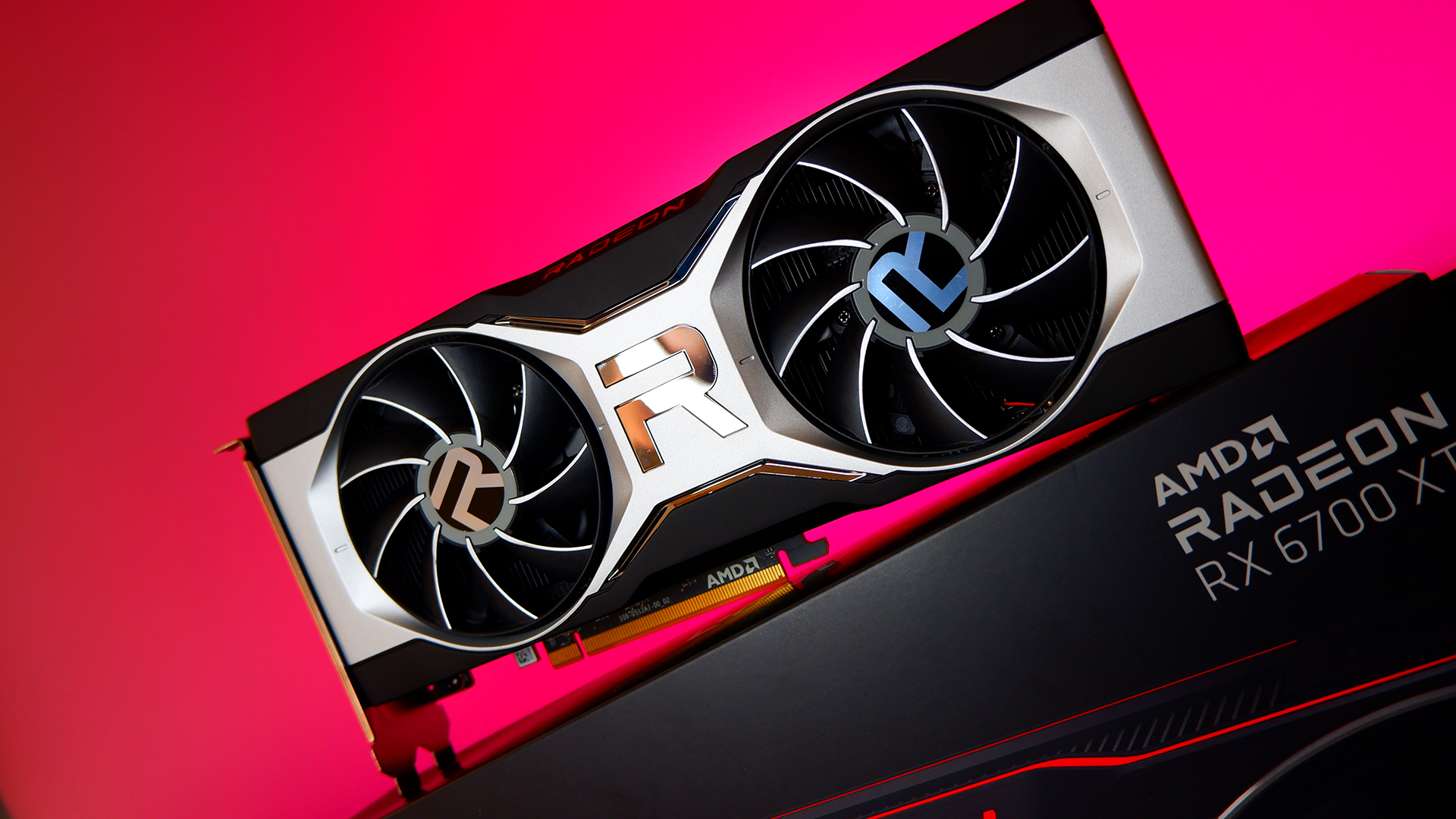
What are the AMD Radeon RX 6700 XT specs?
There's more to the Radeon RX 6700 XT than a simple halving of silicon from AMD's top chip, the Radeon RX 6900 XT. In some ways, sure, it's a straight slice down the middle. The RX 6700 XT features 40 compute units (CUs) for a total of 2,560 RDNA 2 cores and is equipped with 64 ROPs—exactly half of the maximum configuration of the Navi 21 GPU—but the card comes with more than its fair share of memory and Infinity Cache.
A headline feature of AMD's RDNA 2 lineup has been bigger than thou memory capacities compared with rival GeForce GPUs, and the RX 6700 XT doesn't buck that trend. There's 12GB of GDDR6 packed onto this card: an attempt at what we optimistically call 'future-proofing'. That's greater VRAM capacity than the RTX 3060 Ti and RTX 3070, and is a match for the RTX 3060 12GB.
There's 96MB of Infinity Cache on the RX 6700 XT, just a 25 percent reduction from the high-end Navi 21 chips. The Infinity Cache was first introduced with RDNA 2 at the high-end and offered AMD a way to circumvent the need for a wider, more power-hungry memory bus while maintaining memory bandwidth. In the RX 6700's case, the 96MB of Infinity Cache is making up ground for a slim 192-bit bus.
But don't be fooled by talk of saving power, the RX 6700 XT uses every last drop of leftover juice to drive up clock speeds and gaming performance.
RDNA 2 has made quite a name for itself when it comes to operating clock speeds—the Radeon RX 6900 XT would rather happily hit 2.2GHz mid-game—but the RX 6700 XT pushes the limit that much further. Officially rated to 2,581MHz, we saw this card hit 2.4GHz in practice, on par with the listed Game Clock.
GPU: Navi 22
Lithography: TSMC 7nm
Die size: 336 mm2
Transistors: 17.2bn
Stream processors: 2,560
CUs: 40
Ray Accelerators: 40
GPU Game clock: 2,424MHz
GPU Boost clock: 2,581MHz
Memory bus: 192-bit
Memory capacity: 12GB GDDR6
Memory speed: 16Gbps
Memory bandwidth: 512GB/s
TGP: 230W
Price (reference): $479
Only a few years ago that sort of frequency under any circumstance would've been considered extreme, and would have likely required liquid nitrogen and a dab hand at overclocking to achieve. Nowadays, it's possible on a stock card and a reference AMD cooler design. The RX 5700 XT it's ostensibly replacing was rated to 1,905MHz at best. If that's not a testament to AMD's generational gains with RDNA 2, I don't know what is.
That lofty clock speed clearly pushes the RX 6700 XT's power envelope right up, however. It comes in at 230W, only 20W lower than the total graphics power (TGP) of the RX 6800. And while it's only 5W greater than the RX 5700 XT, with all the power considerations of RDNA 2 over RDNA, it's clear that all that AMD gained in power efficiency has been rerouted right back into the Navi 22 GPU for maximum performance.
There are a couple of other advantages of note with the RDNA 2 architecture as a whole worth mentioning here.
Ray Accelerators are key to bringing ray tracing to team red with this generation. The RX 6700 XT comes with 40 of them for a moderate bump of real-time acceleration. That's a relatively mild-mannered solution, though, and while ray tracing is feasible, the RX 6700 XT is not competing with the very best ray tracing cards around by any stretch of the imagination.
From top to tail, you could point to almost any part of the RX 6700 XT to prove what a difference an architectural generation can make
There's also PCIe 4.0 support, which has relatively little impact on any metrics us gamers care about, but if you were to operate this card on a compatible 500-series motherboard and AMD Ryzen 5000 processor, you will also unlock Smart Access Memory capability. For more depth on that feature, check out our SAM benchmarking feature. But long story short: if you can turn it on, there's really no reason not to.
AMD's also touting Radeon Boost, Radeon Anti-Lag, Radeon Chill, FidelityFX Sharpening, and all the usual FreeSync and virtual resolution features we've come to expect from the Radeon Software experience. One important thing that's not yet available is AMD's FidelityFX Super Resolution, which promises some analogue to Nvidia's performance-boosting Deep Learning Super Sampling (DLSS) in one way or another.
We were hoping for a little more information on this feature alongside this launch, but AMD's sticking with the usual 'it's ready when it's ready' line. So, nothing new to report just yet.
Before we dive into the performance figures I think it worth mentioning the reference design, because I feel AMD's made a bit more song and dance about its stock cooler this time around. The Radeon RX 6700 XT features a familiar style to the RX 6800-series and RX 6900 XT reference cooler, which I can take or leave in looks, personally, but it's ditched one of the fans for a more modest dual-fan configuration.
It's more or less the same thing we've come to expect from AMD in this department, but the company has elaborated on the details a little further. There's a 10-layer PCB featuring a 9 (7+2 phase) DrMOS power delivery design, and its dual-fan shroud will run in a zero RPM mode when under light load.
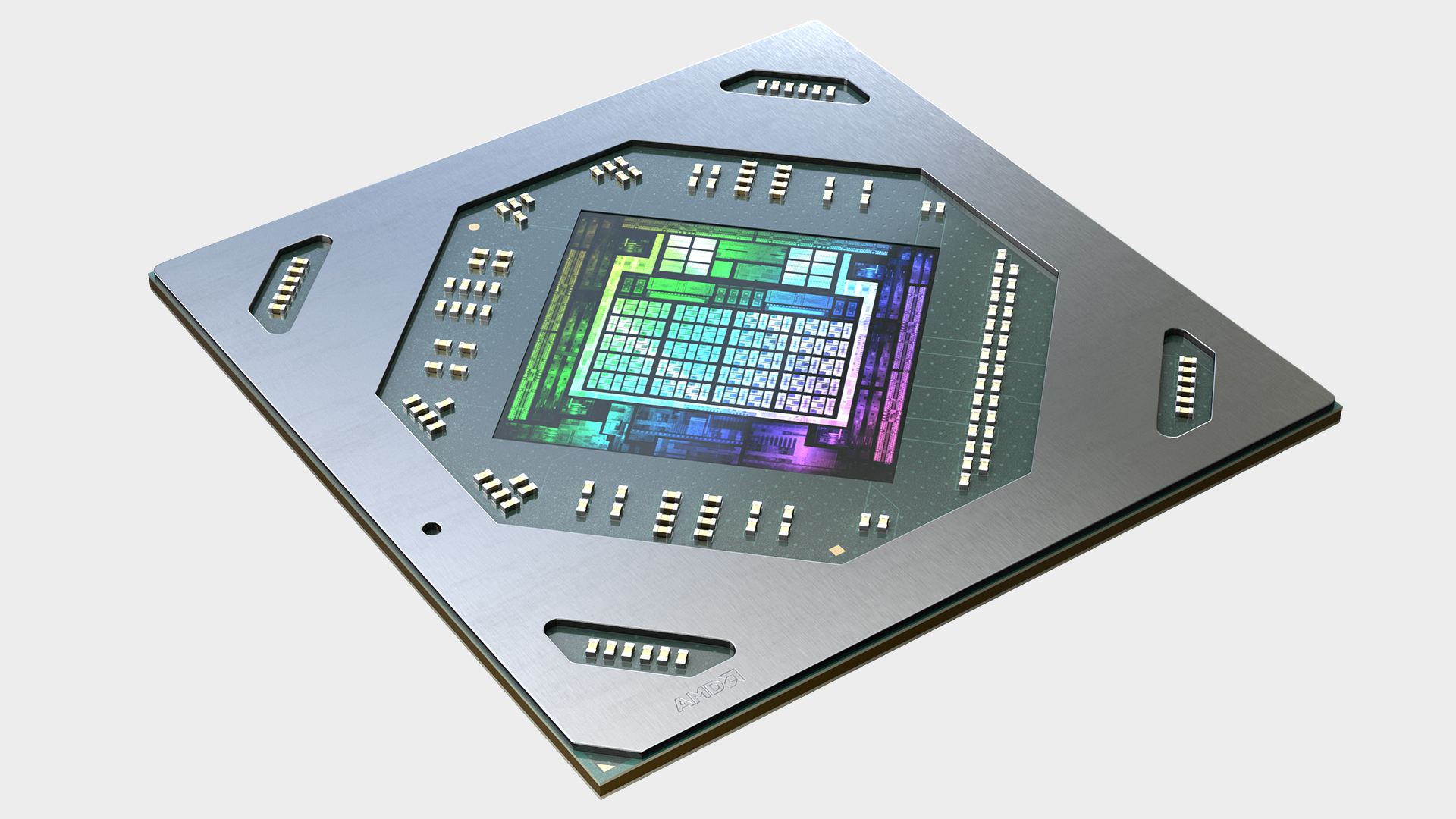
Pretty standard stuff, I dare say, but sure to be popular considering its proficiency for the price. It's a quality cooler at MSRP. Perhaps we're also hearing a little more about AMD"s cooler design due to the company having to conscript the RX 6800-series and RX 6900 XT stock coolers back into service by popular demand—not something AMD may have expected following the slightly controversial RX 5700 XT 'dented' cooler.
I'm in favour of the dent, for the record.
From top to tail, you could point to almost any part of the RX 6700 XT to prove what a difference an architectural generation can make. From the Radeon RX 5700 XT, by some measures the last-generation counterpart to the RX 6700 XT, the gaming performance improvement is quite staggering too, as you'll read below.
But at $80 more it's not like that's a raw generation-on-generation leap in a direct sense. At $479 the Radeon RX 6700 XT instead has to bat away the $399 RTX 3060 Ti by some margin, and compete directly with the $499 RTX 3070. As ever with fundamentally different architectures, though, it's not always quite that clear cut.
Before we get to that, though, it's worth gauging what's realistic in terms of price to performance for this graphics card, and really all others mentioned here. This isn't the first time we've seen a massive demand for a graphics card completely strip supply, but its effects are still as pronounced as ever. That means ballooning costs and far greater than MSRP prices, often even at recognised retailers. The MSRP given at launch will represent the price that some customers will pay for these cards on release but perhaps not what you'll see on the shelves shortly thereafter.
Sadly, things aren't looking up for the graphics card market for reportedly much of the first half of 2021, and the second half of the year is still clouded in mystery. What we know is there's no simple fix for huge demand and low supply.
Specifically in regards to the Radeon RX 6700 XT, AMD's only given us tacit mention it is doing all it can to get cards out to customers. The company also notes that RDNA 2 is not the best of cryptocurrency mining graphics cards, which may reduce the demand from cryptocurrency miners, but I have my doubts as to whether that really makes all that much difference when demand is sky high and there's still money to be made.
Which is all to say our MSRP considerations are idealistic for all but a handful of lucky F5-ers at this time. To weigh up how much you should be willing to spend on any given card if you're happy to punch above the standard fare, though, you need to be well equipped with the performance stats. So onwards to the benchmarks.
Benchmarks & performance
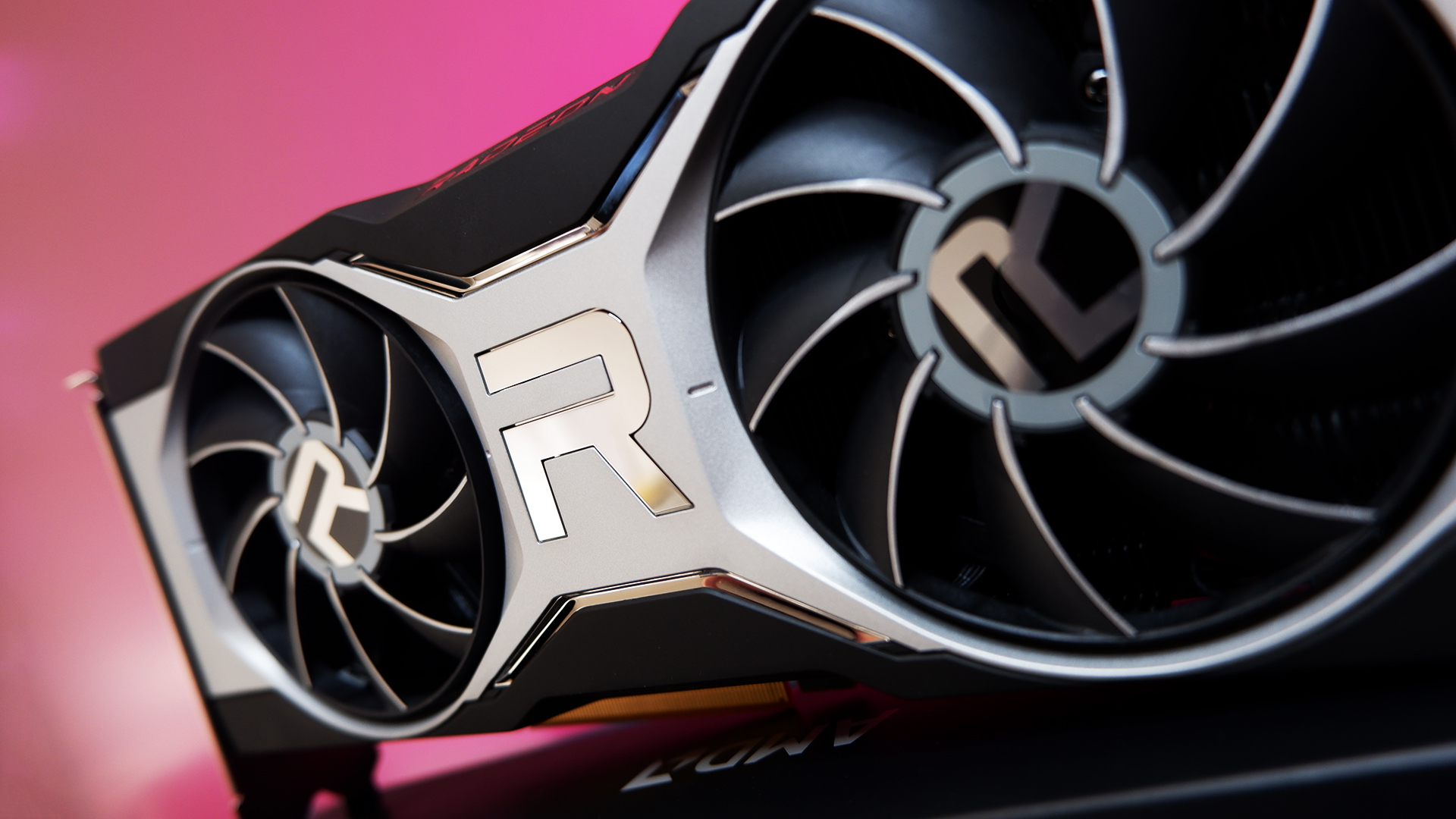
How does the AMD Radeon RX 6700 XT perform?
With Nvidia firing the starting pistol in the mid- to high-end graphics card market it's now up to AMD to shove its way to the front. Its first shot across Nvidia's bow is the Radeon RX 6700 XT, which faces two main competitors at that price and with those performance aspirations.
The closest of the two is the Nvidia GeForce RTX 3070, which will set you back $499 at MSRP, nominally just $20 more than the RX 6700 XT. Below that, there's the RTX 3060 Ti, which is a consideration for AMD's own internal benchmarks but also quite a bit cheaper at $399.
There's no doubt the Radeon RX 6700 XT has some 4K performance in it, but it's likely to find a home in a 1440p or 1080p rig aiming for high frame rates above all else. In that regard, the RX 6700 XT proves itself more than capable.
1080p gaming performance
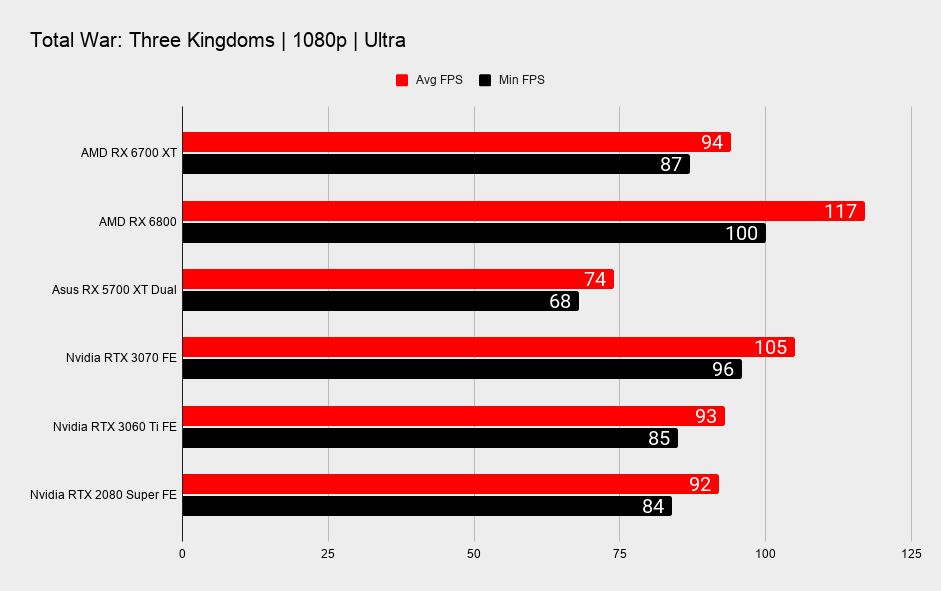

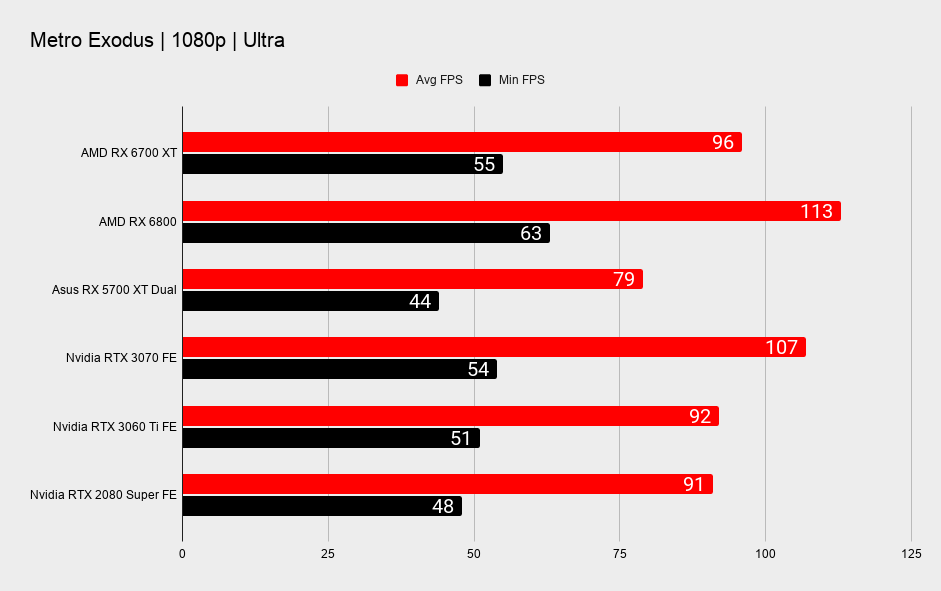



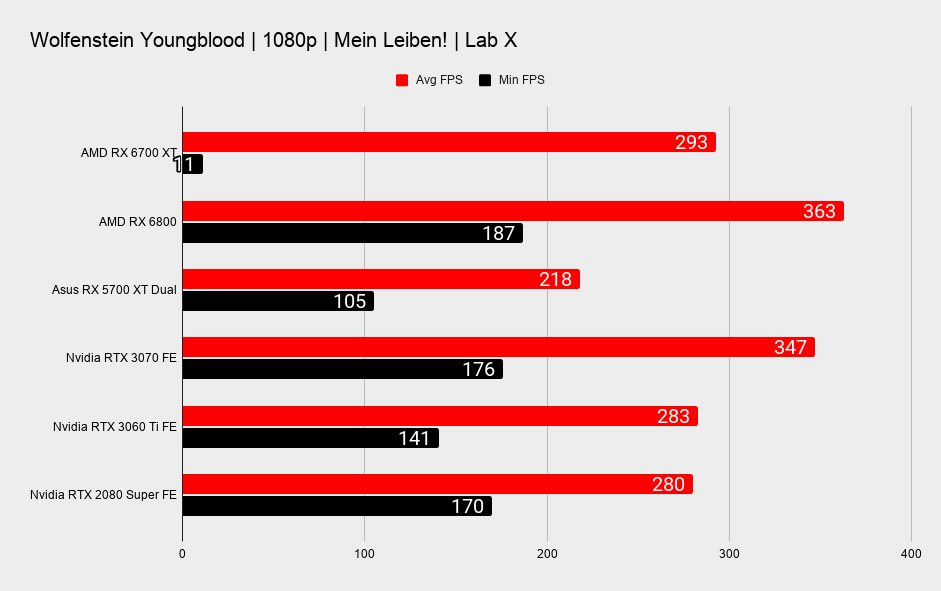
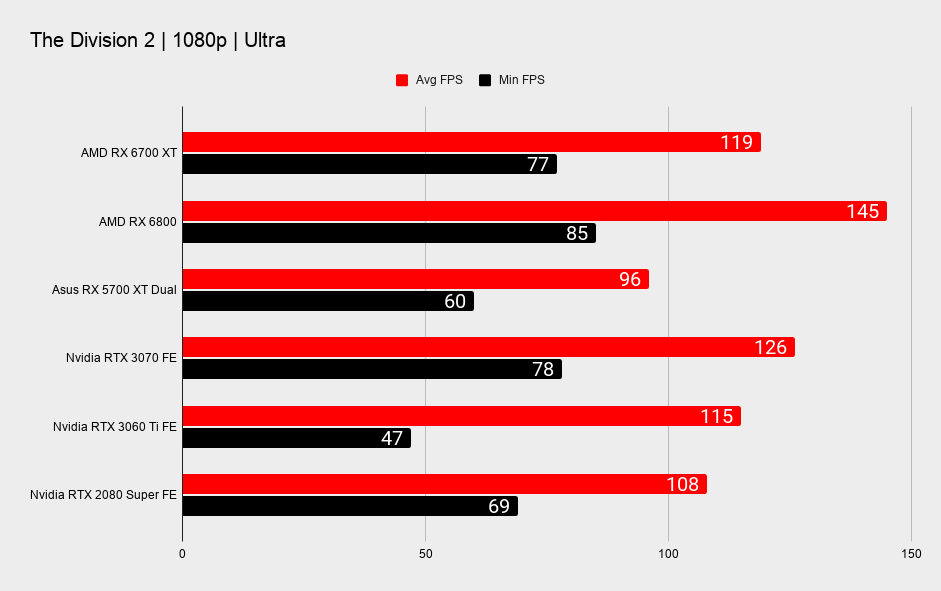
1440p gaming performance
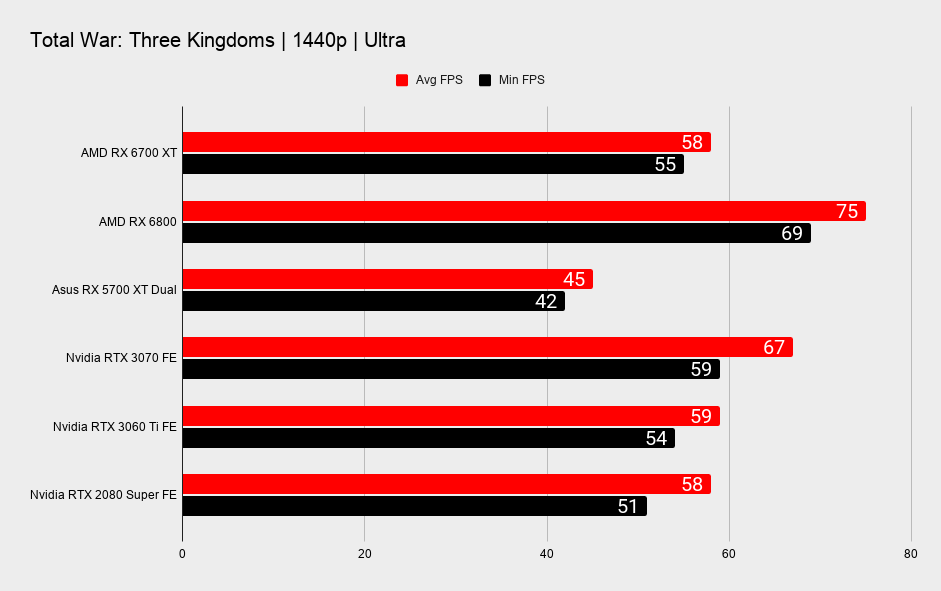
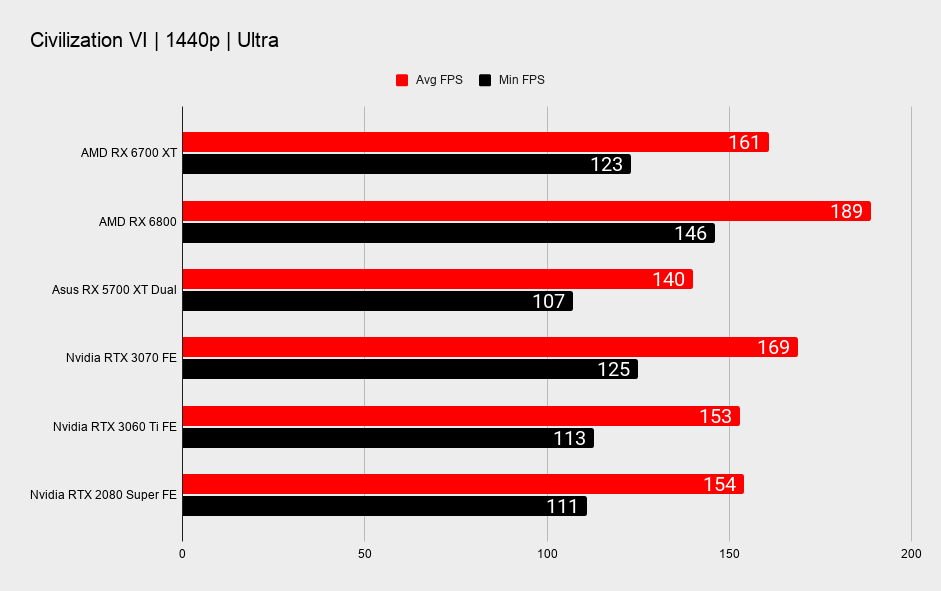
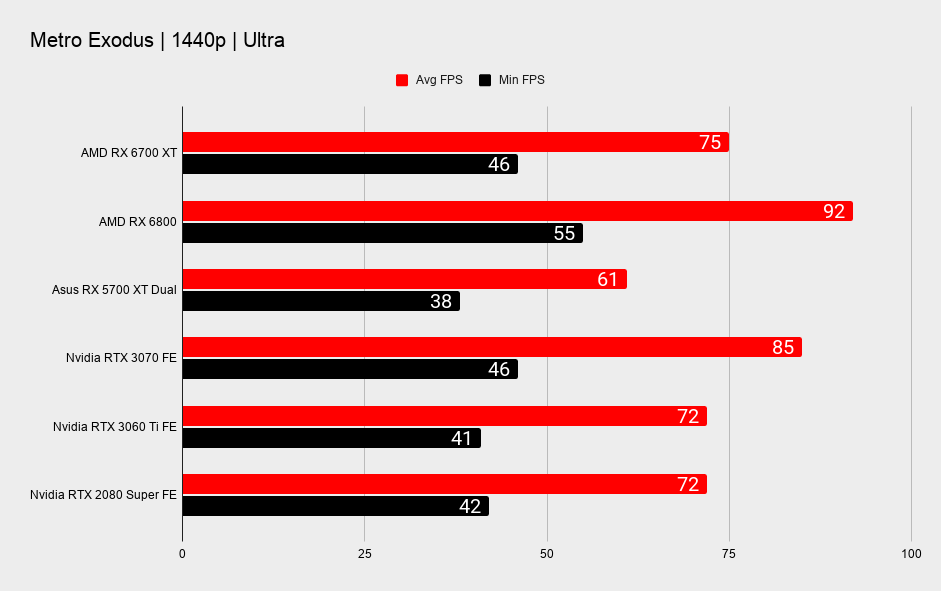
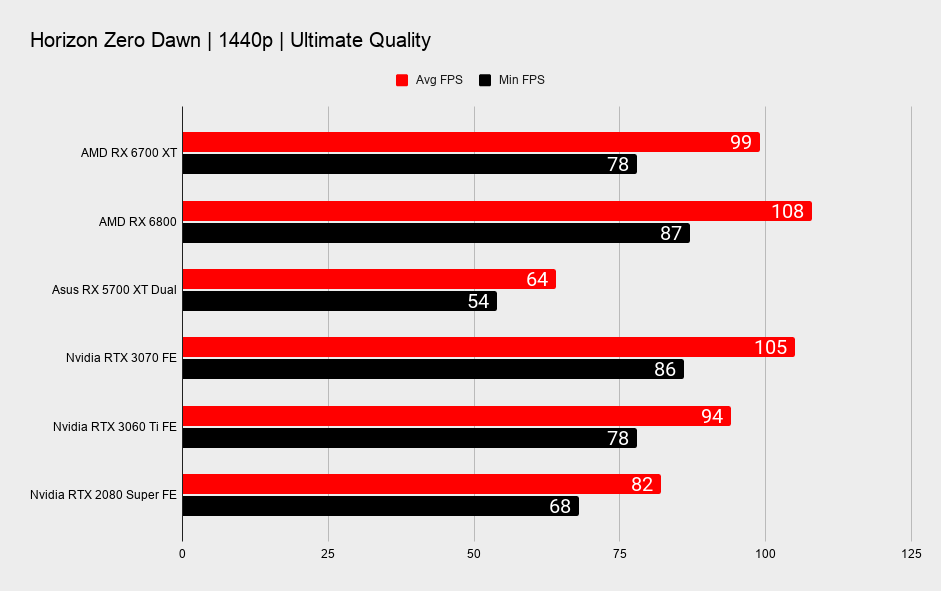
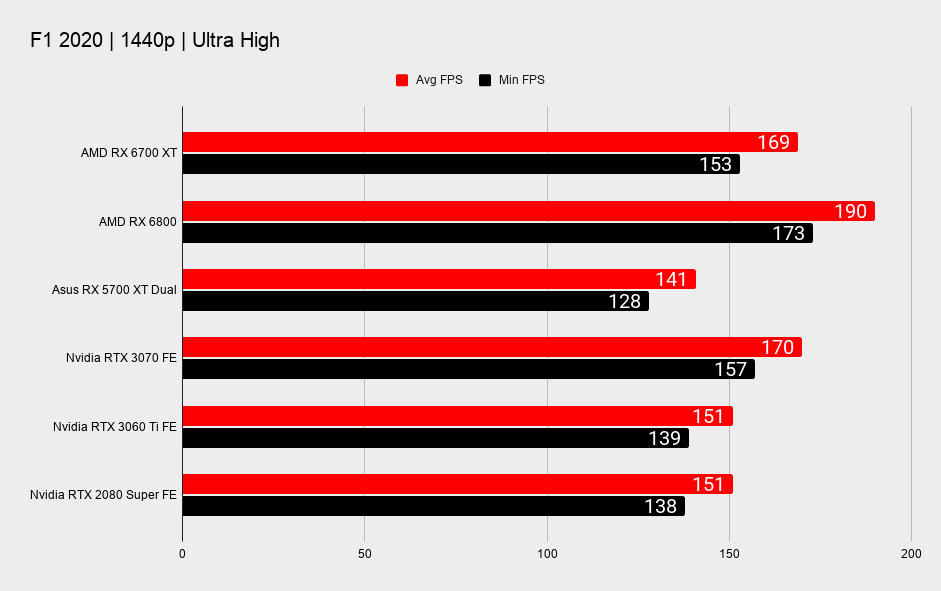

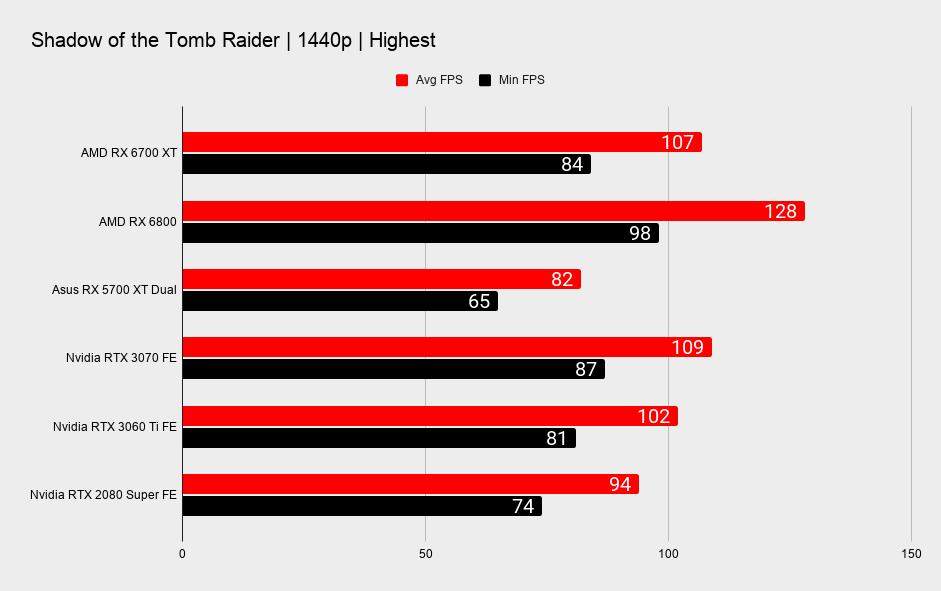

CPU: Intel Core i7 10700K
Motherboard: MSI MPG Z490 Gaming Carbon WiFi
RAM: Corsair Vengeance RGB Pro @ 3,200MHz
CPU cooler: Corsair H100i RGB Pro XT
PSU: NZXT 850W
Chassis: DimasTech Mini V2
Performance up to 144fps is largely within reach in most games in our benchmarking suite, which is a mix of fairly recent titles, if only falling short when really cranked up to the highest settings. A few tweaks in the most demanding games should see this card make the most of a high refresh rate 1080p screen. At 1440p, you're perhaps looking a little less likely to fully maximise 144Hz or greater panels in more demanding triple-A titles, but competitive shooters and the like shouldn't cause this card to sweat much.
Performance versus Nvidia's competition can really swing dramatically on a game-by-game basis, however.
The RTX 3070 tends to lead the way in all our benchmarks besides F1 2020 at 1080p, which is a game we tend to see favour red team silicon. The RX 6700 XT also draws pretty close in Shadow of the Tomb Raider, just under four percent off the pace at 1080p and two percent at 1440p.
But even these sporadic gains cannot be continued throughout, and certainly not at 4K. It's not exactly this card's wheelhouse but 4K, and to a lesser degree 1440p, is where the RTX 3070 really comes into its own and starts pulling ahead. You'll occasionally find the RX 6700 XT closing the gap at 1440p but never close to competing when the mass of pixels required for 4K are involved.
4K gaming performance


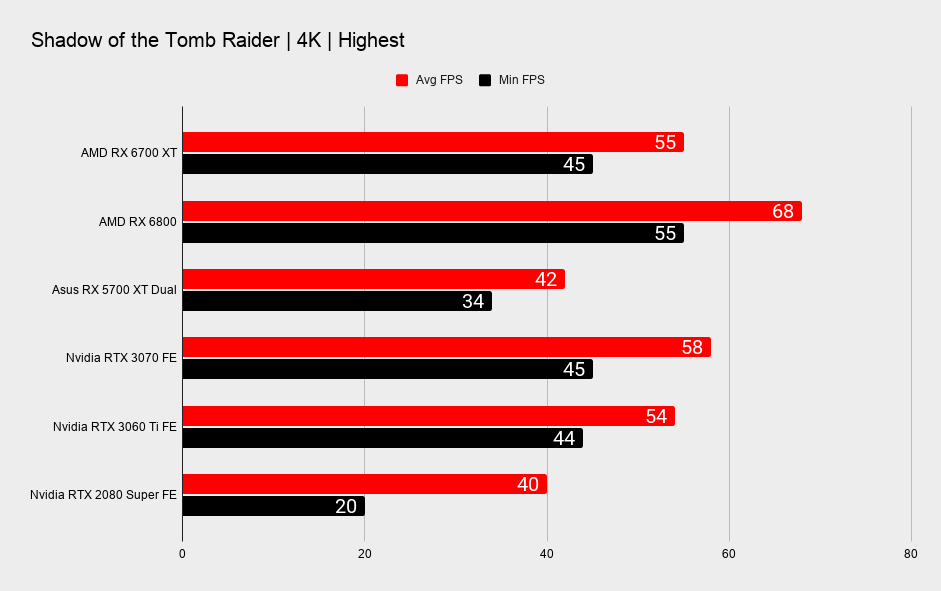

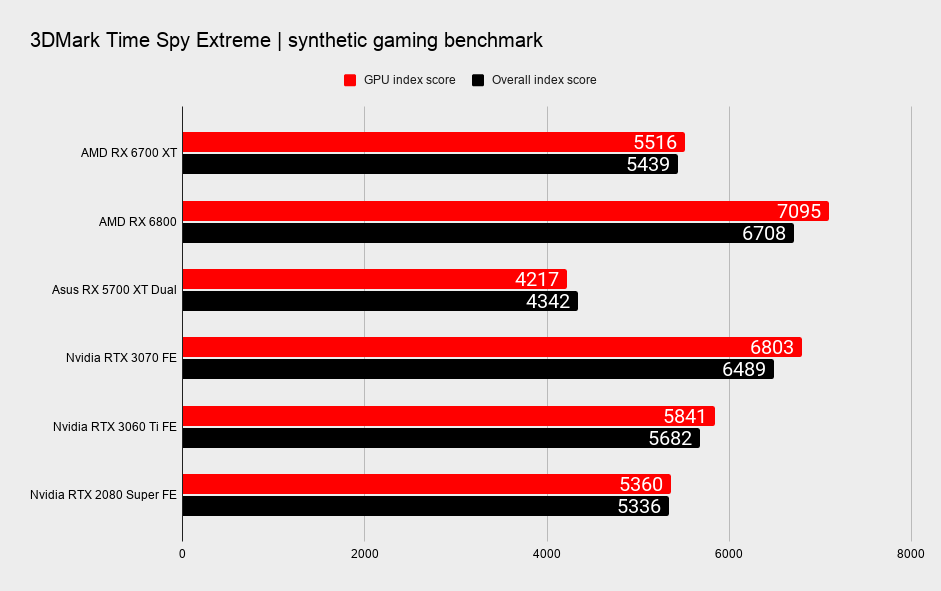

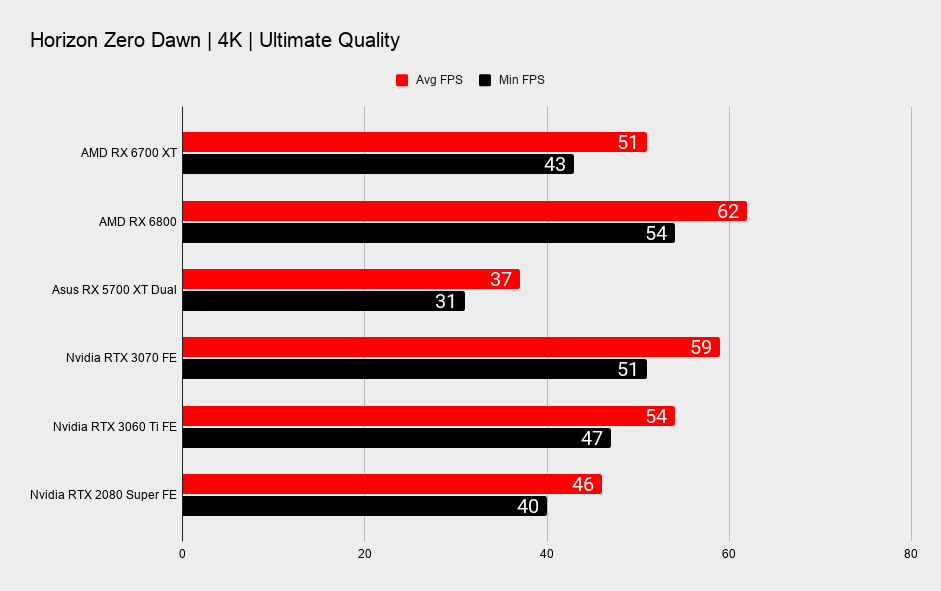
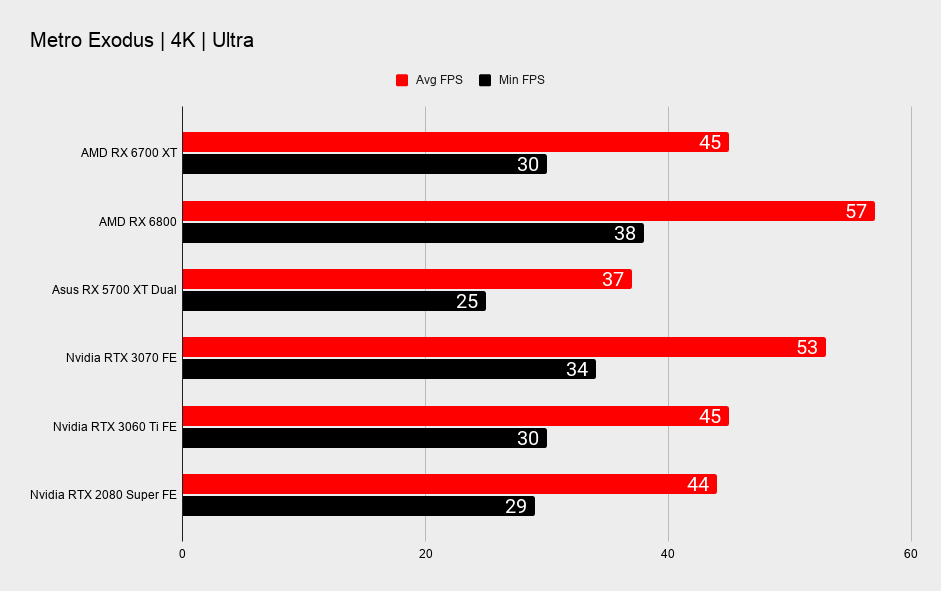

I think these results tell you all you need to know for the RX 6700 XT's chances against the RTX 3070 for the sub-$500 title.
Before we get to that, however, there's the little matter of the RTX 3060 Ti. Versus the cheaper Ampere chip, the RX 6700 XT leads the way at 1080p, by more than a nominal amount, if quite a bit short of spectacular gains. At 1440p, it's faster in more games than it's not.
It's once again where you look at 4K performance—which admittedly is neither of these cards' real target resolution—that highlights something of a pattern occurring for the RX 6700 XT. My guess would have it down to the hit rates on the Infinity Cache, but perhaps it's a case of Ampere's raw FP32 core count that helps with the demands of the high resolution. Either way, the RX 6700 XT really drops the ball even versus the cheaper of the two Nvidia GPUs when it comes to 4K frame rates.
The Radeon's lead shrinks a noticeable amount at 4K and allows the RTX 3060 Ti to play catch up, if not entirely catch up and even surpass the $80 more expensive card in some benchmark runs.
Ray tracing performance
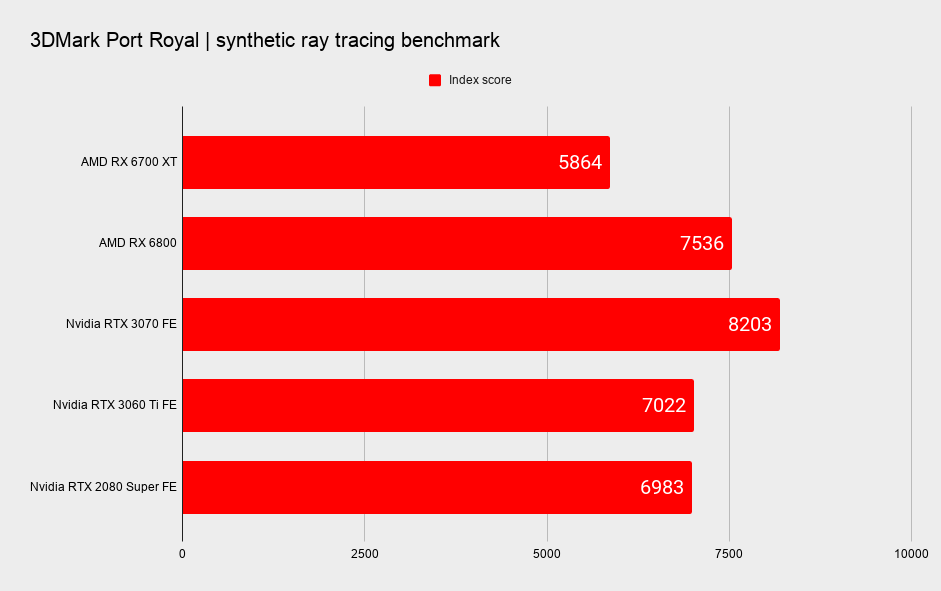
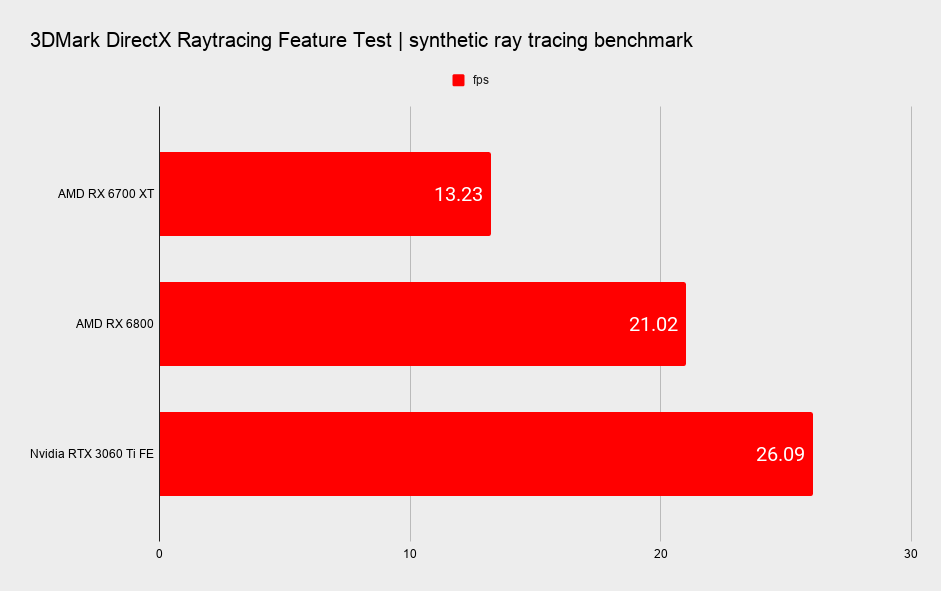
And I can't say the remaining ray tracing benchmarks do much to sweeten the AMD deal here. In fact, they have the complete opposite effect, and Nvidia's more performant ray tracing architecture has its two cards significantly leading the way in real-time ray tracing workloads.
In performance per watt, the RX 6700 XT manages to stay abreast of the RX 6800 at 4K but slips massively under in efficiency at 1080p. Which is hardly surprising considering its absolutely mammoth clock speeds kept afloat by average power demands only a hair's breadth off the larger RX 6800. That's a card with 50% more cores packed onto the silicon. While power demands are far from a linear curve, the RX 6700 XT is rather staggeringly just 23W shy of its much bigger sibling in average power consumption.
Power and thermals

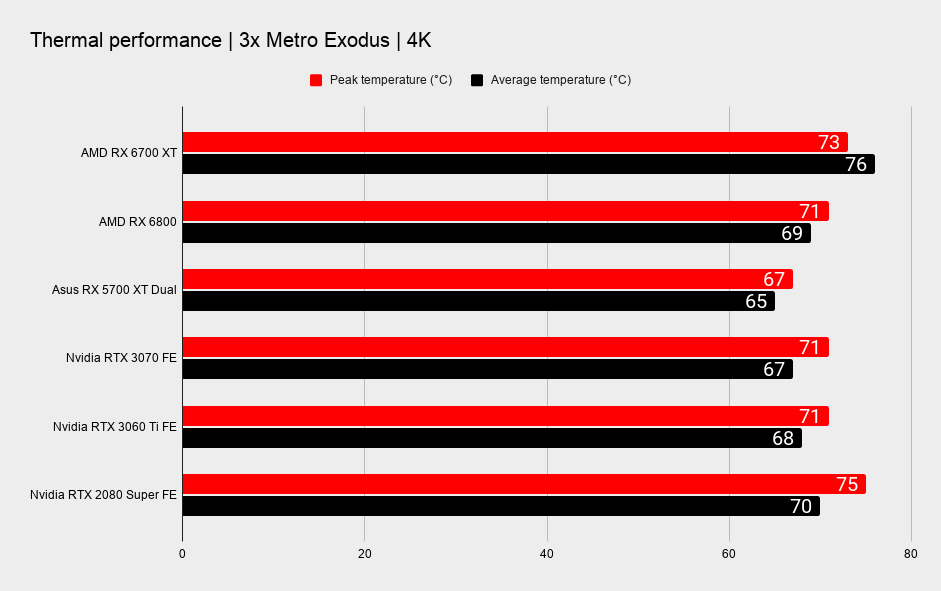
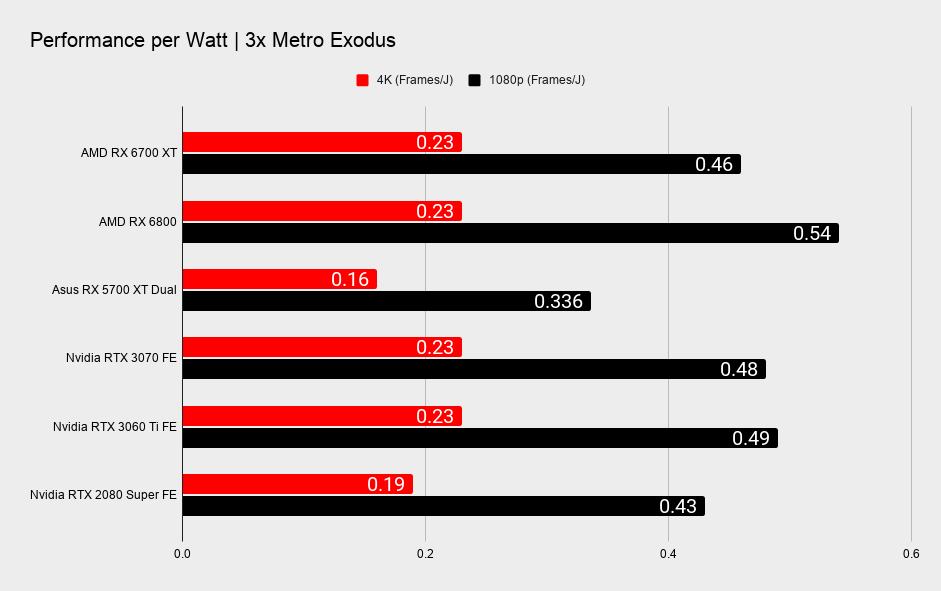
It's clear AMD's thrown everything at the Radeon RX 6700 XT to get it close to the RTX 3070, but when it's not quite competing there, and not quite cheap enough either, I'm not sure even impressively quick clock speeds can save it.
And while we're on the subject of clock speeds, perhaps not surprising anyone, the RX 6700 XT fell over almost immediately with the same OC as the other RDNA 2 cards of +156MHz. That's not a small core OC by any means, but when this card appears to be running at the absolute limit at stock, even handing it another 15 percent power limit to play with wasn't enough to keep it stable at the ragged edge.
Finally, onto cooling performance, and it's no surprise to see AMD's effective reference design sweep comfortable temperatures with relatively low noise—impressively low when compared to its previous blower-style reference designs, in fact.
Analysis
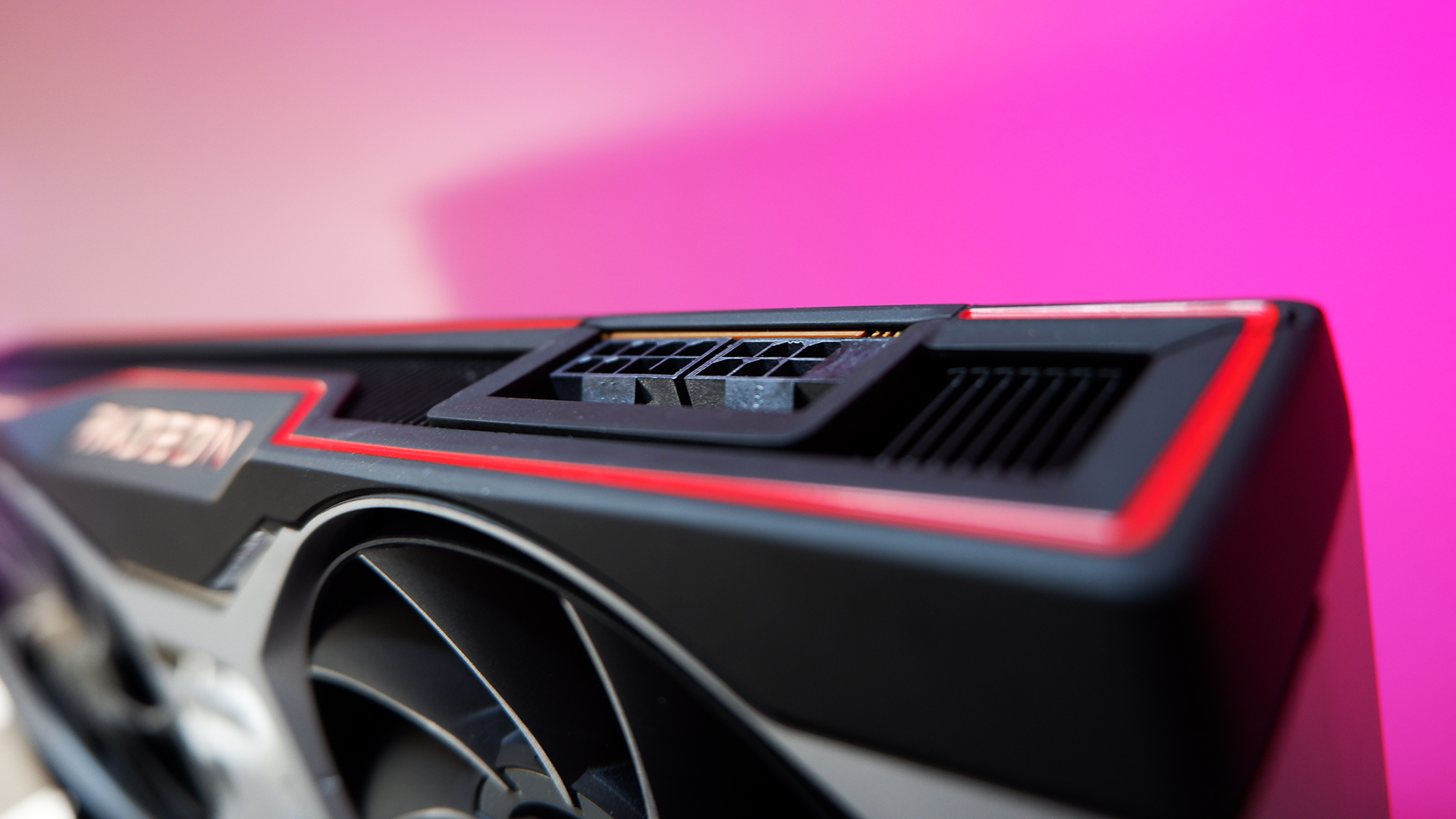
What does the AMD Radeon RX 6700 XT mean today?
The RX 6700 XT is fighting two key battles here: one in performance versus the RTX 3070 and the other in price versus the RTX 3060 Ti.
On the first count, the $20 that separates these two cards is not enough for me to countenance the loss in performance, to varying degrees, across three key areas: 4K performance, 1440p performance, and ray tracing performance. That's all without factoring in DLSS, which is sure to bolster Nvidia's performance in supported titles and which AMD currently has no answer for or ecosystem to speak of. Hopefully we hear more about that soon, but I don't think it will change all that much for the better part of this generation's lifespan.
On the second count, we're really discussing whether the extra $80 of the RX 6700 XT is worth it up from the RTX 3060 Ti. And again, I don't believe it is, although this is less of an open and shut case than with the RTX 3070.
I think you could make the case that there's enough of an uplift at 1080p, without any extra features such as ray tracing or upscaling, to make the RX 6700 XT a justifiable card at 1080p and 1440p for high refresh gaming. At 4K, even that argument goes out the window, but leaving it aside I think you could make those claims.
Going back to an argument I've found myself making with AMD's RDNA 2 graphics cards a lot: In solitude, this is not a graphics card entirely without merit. For the price, if you can get it an MSRP, you are going to experience perfectly playable frame rates with support for the latest features in DX12 and beyond.
And really that is the consumer experience, so I'm not going to discount it. This card being independently valuable, beyond comparison to the competition, is an important metric. And while purchasing a graphics card currently necessitates excruciating patience, split-second decision making, and rapidly hitting the checkout button, perhaps it's even more crucial to know that you will still receive a powerful and competent GPU if you rush to buy now, over, say, at some point in the future when you may have more options available to you.

Once you do indeed have more purchase options, such as Nvidia's RTX 3070 and RTX 3060 Ti, the RX 6700 XT becomes a much tougher sell. The raw performance isn't quite there for the price, at least not where AMD's positioned itself between these two GeForce cards. The Radeon RX 6700 XT is not cheap enough to snap up price-conscious buyers on the fence—dare I even mention third-party cards that price themselves above the RTX 3070 at MSRP—and it's a little too expensive to pull away potential RTX 3060 Ti buyers with the performance on offer.
Perhaps the positioning of this card will make a little more sense once the remaining Radeon RX 6700, RX 6600, etc. graphics cards are announced further down the stack. But for now we have no visual on when those may drop or how they'll perform.
The same goes for FidelityFX Super Resolution and the so-far nebulous promise of performance at some point in some games. Once you finally factor in the supplementary features that Nvidia's currently offering, those which it is offering right now, and useable from the moment you receive the card, they only serve to further shift our attention onto Nvidia's graphics cards as opposed to AMD's.

GPUs are a precious commodity but you don't necessarily need one for gaming. Here's our ultra budget gaming PC build guide—a gaming rig for less than the price of a graphics card.
The elephant in the room is memory capacity, and it's the redeeming factor for AMD here. The RX 6700 XT's 12GB of GDDR6 memory is where AMD has Nvidia on the ropes in these two key battles. Unfortunately for AMD, that doesn't seem to be giving it much of a benefit today, and weirder so, this card is even slipping up compared to Nvidia's 8GB GDDR6 cards at 4K, the resolution that should be more demanding of memory capacity than any other.
Again, that could be the trade off in capacity for the Infinity Cache on the Navi 21 chip, although as I mentioned previously this GPU is actually surprisingly well equipped in cache size for its core count, or it's down to the volume of FP32 cores with Nvidia's Ampere architecture winning through sheer brute force alone.
I can only speculate as to how this may shake out going forward. My gut feeling is we will see increasing demand for memory capacity in the latest games over the next few years, but the impact that may have on graphics cards with a less than desirable memory is entirely up in the air. One can only assume it will vary massively by how scalable the game engine is for any given game and how prepared you, the player, are to drop your graphics settings.
However it ends up shaking out, the Radeon RX 6700 XT is well equipped for that future with 12GB of GDDR6. Which is something you can say perhaps with a higher degree of confidence than the RTX 3070 and RTX 3060 Ti's 8GB. But even saying that I'm far from convinced any memory impact will be severe enough to rule out any one of these cards for their lifetimes.
Verdict

Closing thoughts
I had thought this sure to be the shortest of the graphics cards reviews I will have written over the past few months, but it may end up being the longest. So I'll keep the summation short. AMD's Radeon RX 6700 XT is a good card, but not necessarily a great one. That's down to cost more so anything else.
With a price tag closer to the GeForce RTX 3070, yet performance between it and the GeForce RTX 3060 Ti, most often closer to the latter, the Radeon is a solid alternative but not my first port of call. Not for the builder with $400 to spend on a new graphics card or closer to $500.
RDNA 2 is an impressive architecture, let it be said, and what a spectacular generation-on-generation play it is. No doubt AMD will currently sell every single GPU it manufactures. But the RX 6700 XT falls into the same ambivalent area we've seen the latest Radeon cards slip in to by varying degrees: AMD is an admirable alternative. There's just not enough oomph behind the architecture to give it the lead it requires in anything but the games most in favour of AMD's GPUs. And, while it could be priced accordingly to push it in the right direction, the actual price is nowhere near aggressive enough for it to become that value champion that we've seen from our AMD favourites of old.
I say all of this in the knowledge that picking up any graphics card, let alone one with a cutting-edge architecture, is a win in 2021
That's not to say the Radeon RX 6700 XT doesn't offer a decent gaming experience. In fact, I'll go one better. The RX 6700 XT delivers a superb 1080p and 1440p gaming experience with the memory capacity to keep you ahead of the curve for likely a few years to come. But with some key features still on ice at AMD's labs, such as FidelityFX Super Resolution, and a competing feature set from Nvidia that's currently very strong, there's nothing added here that really puts AMD on the front foot.
I say all of this in the knowledge that picking up any graphics card, let alone one with a cutting-edge architecture, is a win in 2021. If you can get luck on your side and snag a Radeon RX 6700 XT for MSRP, even one with a capable cooler such as AMD's reference design, you will not be disappointed when you plug that card in and see what RDNA 2 has to offer.
In an ideal world, where you have options available to you, the RX 6700 XT is not my first choice for a sub-$500 GPU. But then we're most assuredly not in an ideal world, are we?
A dab hand at 1080p and 1440p, the Radeon RX 6700 XT is a performant graphics card for 2021 and beyond. However, it simply isn't priced aggressively enough to snatch the sub-$500 market from Nvidia.

Jacob earned his first byline writing for his own tech blog. From there, he graduated to professionally breaking things as hardware writer at PCGamesN, and would go on to run the team as hardware editor. He joined PC Gamer's top staff as senior hardware editor before becoming managing editor of the hardware team, and you'll now find him reporting on the latest developments in the technology and gaming industries and testing the newest PC components.


